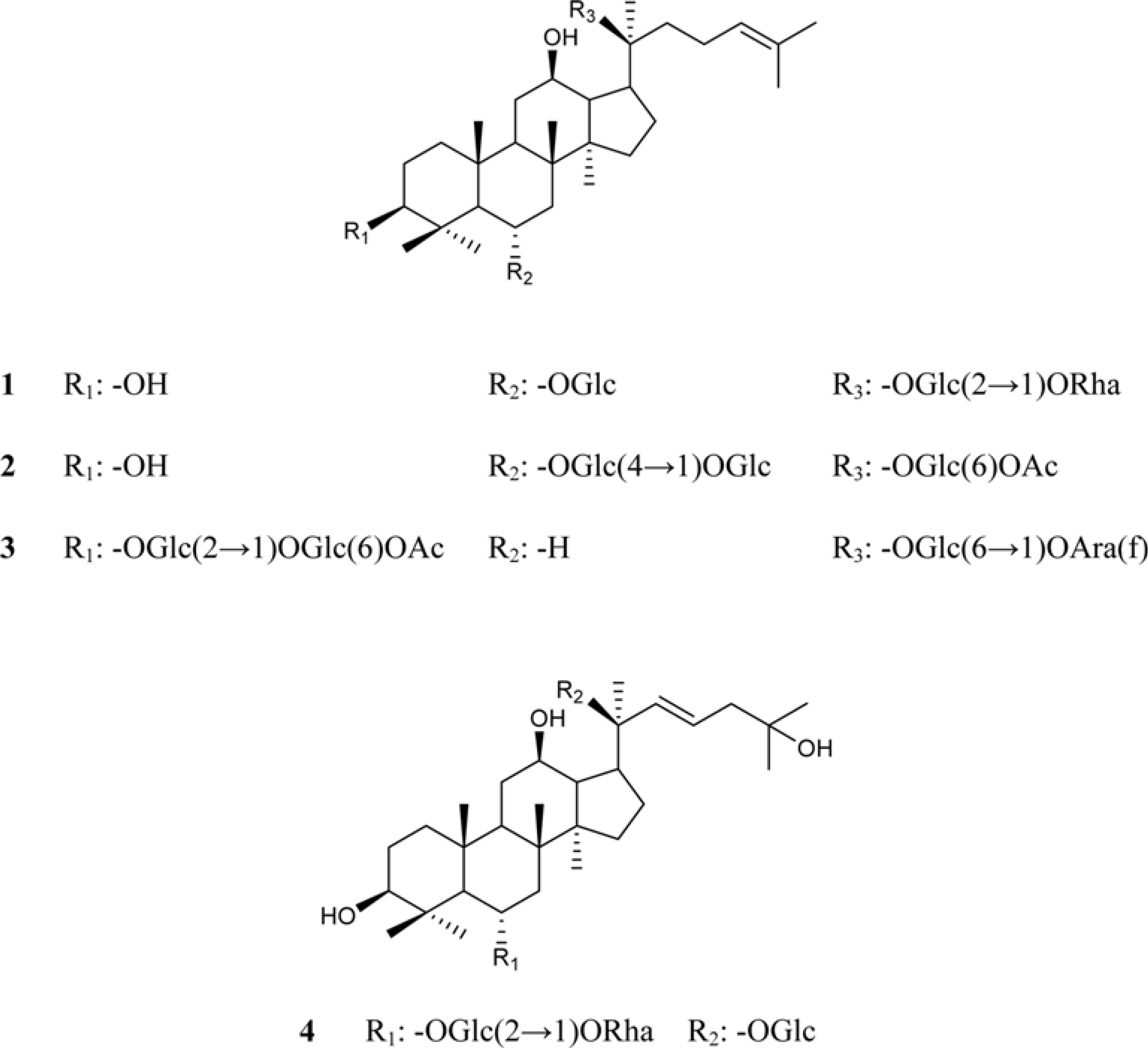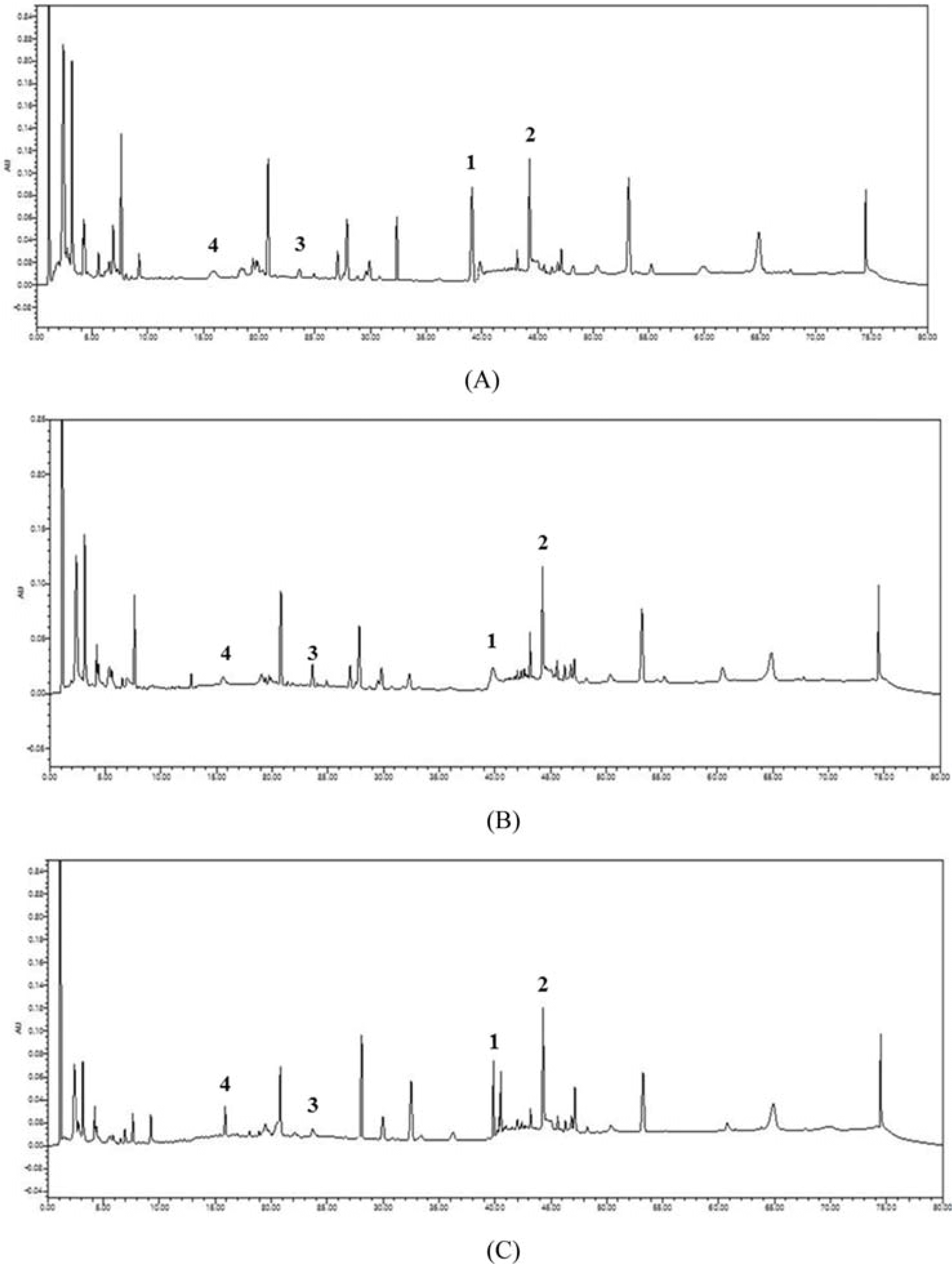Abstract
Ginseng products available in different forms and preparations are reported to have varied bioactivities and chemical compositions. In our previous study, four new dammarane-type ginsenosides were isolated from Panax ginseng, which are ginsenoside Rg18 (1), 6-acetyl ginsenoside Rg3 (2), ginsenoside Rs11 (3), and ginsenoside Re7 (4). Accordingly, the goal of this study was to determine the distribution and content of these newly characterized ginsenosides in different ginseng products. The content of compounds 1–4 in different ginseng products was determined via HPLC-UV. The samples included ginseng roots from different ginseng species, roots harvested from different localities in Korea, and samples harvested at different cultivation ages and processed under different manufacturing methods. The four ginsenosides were present at varying concentrations in the different ginseng samples examined. The variations in their content could be attributed to species variation, and differences in cultivation conditions and manufacturing methods. The total concentration of compounds 1–4 were highest in ginseng obtained from Geumsan (185 µg/g), white-6 yr ginseng (150 µg/g), and P. quinquefolius (186 µg/g). The results of this study provide a basis for the optimization of cultivation conditions and manufacturing methods to maximize the yield of the four new ginsenosides in ginseng.
REFERENCES
(1). Li T.S.C.Hort. Technol. 1995; 5:27–34.
(2). Coon J.T., Ernst E.Drug Safety. 2002; 25:323–344.
(3). Attele A., Zhou P., Xie J.T., Wu J.A., Zhang L., Dey L., Pugh W., Rue P., Polonsky K., Yuan C.S.Diabetes. 2002; 51:1851–1858.
(4). Shibata S. J.Korean Med. Sci. 2001; 16:S28–37.
(4). Shibata S. J.Korean Med. Sci. 2001; 16:S28–37.
(5). Siddiqi M.H., Siddiqi M.Z., Ahn S., Kang S., Kim Y.J., Sathishkumar N., Yang D.U., Yang D.C.J. Ginseng Res. 2013; 37:261–268.
(7). Karu N., Reifen R., Kerem Z. J.Agric. Food Chem. 2007; 55:2824–2828.
(8). Yue P.Y.K., Mak N.K., Cheng Y.K., Leung K.W., Ng T.B., Fan D.T.P., Yeung H.W., Wong R.N.S.Chin. Med. 2007; 2:1–21.
(9). Jang H.E., Jung H.J., Mok H.J.Appl. Biol. Chem. 2017; 60:321–326.
(10). Proctor J.T., Bailey W.Hort. Rev. 1987; 9:187–236.
(11). Baeg I.H., So S.H. J.Ginseng Res. 2013; 37:1–7.
(12). Wang W., Zhao Y., Rayburn E., Hill D., Wang H., Zhang R.Cancer Chemother. Pharmacol. 2007; 59:589–601.
(13). Wang J., Li S., Fan Y., Chen Y., Liu D., Cheng H., Gao X., Zhou Y. J.Ethnopharmacol. 2010; 130:421–423.
(14). Matsunaga H., Mitsuo K., Yamamoto H., Fujito H., Mori M., Takata K.Chem. Pharm. Bull. 1990; 38:3480–3482.
(15). Joo K.M., Park C.H., Jeong H.J., Lee S.J., Chang I.S. J.Chromatography B. 2008; 865:159–166.
(16). Christensen L.Adv. Food. Nutr. Res. 2008; 55:1–99.
(17). Lee D.G., Lee A.H., Kim K.T., Cho E.J., Lee S.Chem Pharm Bull. 2015; 63:927–934.
(18). Lee C.R., Whang W.K., Shin C.G., Lee H.S., Han S.T., Im B.O., Ko S.K. Kor. J.Food Sci. Technol. 2004; 36:847–850.
(19). Lee S.A., Liuting H.K., Im B.O., Cho S.H., Whang W.K., Ko S.K. Kor. J.Pharmacogn. 2010; 41:319–322.
(20). Ahn S.I., Kim S.K., Yang B.W., Lee E.S., Kang C.S., Hahm Y.T. Kor. J.Hort. Sci. Tech. 2016; 34:790–798.
(21). Dong H.D., Cho C.W., Kim Y.C., Kim E.Y., Rhee Y.K., Rho J.H., Choi S.H. J.Ginseng Res. 2012; 36:314–321.
(22). Lim C.Y., Moon J.M., Kim B.Y., Lim S.H., Lee G.S., Yu H.S., Cho S.I. J.Ginseng Res. 2015; 39:38–45.
(23). Cui J.F.Eur. J. Pharm. Sci. 1995; 3:77–85.
(24). Keum Y.S., Park K.Y., Lee J.M., Chun K.S., Park J.H., Lee S.K., Kwon H.J., Surh Y.J.Cancer Lett. 2000; 150:41–48.
(25). Kim D.H. J.Ginseng Res. 2012; 36:1–15.
(26). Lee M.J., Choi J.S., Woo S.W., Lee K.S., Lee Z.W., Hwang G.S., Lee S.H., Kamal A.H.M., Jung Y.A., Seung N.S., Woo S.H.Process Biochem. 2011; 46:258–264.
Fig. 1.
Chemical structures of ginsenoside Rg18 (1), 6-acetyl ginsenoside Rg3 (2), ginsenoside Rs11 (3), and ginsenoside Re7 (4).

Fig. 2.
Calibration curves of ginsenoside Rg18 (A), 6-acetyl ginsenoside Rg3 (B), ginsenoside Rs11 (C), and ginsenoside Re7 (D).

Fig. 3.
HPLC chromatogram of the standard mixture of ginsenoside Rg18 (1), 6-acetyl ginsenoside Rg3 (2), ginsenoside Rs11 (3), and ginsenoside Re7 (4).

Fig. 4.
HPLC chromatograms of the EtOH extracts of samples from Geumsan (A), Red-4 yr ginseng (B), and P. quinquefolius (C).

Table 1.
Content of ginsenosides 1–4 in ginseng samples from different localities in Korea
Table 2.
Content of ginsenosides 1–4 in ginseng harvested at different cultivation ages and processed under different manufacturing methods
Table 3.
Content of ginsenosides 1–4 in different ginseng species




 PDF
PDF ePub
ePub Citation
Citation Print
Print


 XML Download
XML Download